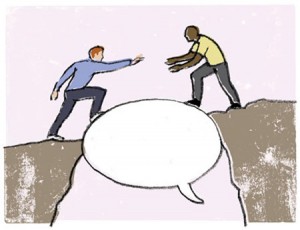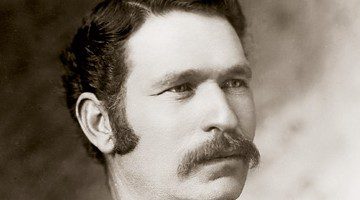Through sincere personal interactions, leaders can change people and transform organizations.

When I arrived at BYU eight years ago, I was in my office organizing books and filing papers when I received a phone call informing me that there had been a glitch in payroll processing and that I would not be receiving a paycheck during the first two months of my employment. I said thank you, hung up the phone, and started thinking about how to break the news to my wife, Jan. Within minutes there was a knock at my office door. It was Ned C. Hill, who was then dean of the Marriott School of Management, and he was paying me an unexpected visit.
I made a place for him to sit down as he explained that he had just been informed about the payroll glitch and that he wanted to know what he could do to help me. I could see the sincerity in his face and hear the concern in his voice. In one hand he was holding what appeared to be his personal checkbook. In the other hand he was holding a pen that was already clicked. After I assured him that the LeBaron family would be fine, he asked about our move to Utah, my plans for research and teaching, and so forth. We talked briefly, and then he left.
With his visit of five minutes, Dean Hill quickly won me over. Instead of calling me to his office, sending an e-mail, or delegating the matter, he had walked across the building to have a brief face-to-face conversation. Although the interaction was not long, I felt heard, understood, and valued.
When Dean Hill talked to the faculty in the Marriott School, people listened receptively. When he gave new directions, people followed respectfully. Our new dean, Gary C. Cornia, also practices the power of face-to-face leadership. To have a conversation with Gary is to feel like you have a friend in the dean’s office. That’s what I want to talk about today—not the grand public speeches to large audiences that we usually associate with leadership, but rather the relatively private conversations whereby leaders change people and transform organizations.
Face-to-Face Leadership
For about 16 years I have been doing research on organizational behavior and leadership. Using microphones and video cameras, I go into organizations in which people are working and leading, and I capture their behavior “in the wild.” For me, leadership is not an abstract notion but rather a rich description of what people actually do.
When I want to observe and assess a leader’s effectiveness, my favorite times to look at are moments of transition. Like the green that grows in the cracks of a sidewalk, leadership usually springs to life between activities and at the edges of events. For example, when I videotape a board meeting, I usually start recording before anyone has entered the room, because I have found that sometimes the most important displays of leadership happen before the meeting actually begins. “Boundary moments,”1 such as openings and closings of conversations or meetings, are especially revealing.
To illustrate, here’s a transcript of the opening of a telephone conversation at work. Within seconds the participants display a close, friendly relationship. Read carefully—this boundary moment happens very fast:
Art: [He picks up] Hello?
Bob: Hey!
Art: HEY!
Bob: Hey!
Art: What’s happening?
Bob: Hey, buddy!
Art: Is this my buddy?
Bob: Hey, you ain’t got no buddies!
Art: What’s happening?
Bob: Hey!
Art: HEY!
Bob: Did uh—
Art: You ready for Thanksgiving?
Bob: Yes.
Art: All right!
That took 12 seconds. But within those 12 seconds, Art and Bob do important work. When Art picks up the phone and says hello, he shows that he is available. When Bob says “Hey!” at line 2, he shows that he can recognize Art’s voice. When Art repeats “HEY!” at line 3, he loudly and enthusiastically shows both recognition and high regard. Through the next 12 lines of their conversational play, such as their inane repetition of the words hey and buddy, they quickly communicate at least four important messages:
I hear you.
I understand you.
I like you.
I can work with you.
Art does not assert his power over Bob. He does not invoke an organizational title. Instead, he engages with Bob to instantiate a close, cooperative, and creative relationship, the sort of relationship that may help their organization thrive.
In contrast, here’s the transcript of an excerpt from a different conversation at a different organization. These are the words of Eric, the owner and CEO of a company, as he talks to his management team at the start of a two-hour meeting:
Eric: Where I’m at, I have to look at the assets in each and every one of you. ’Cause, you know, I could get real caught up in the negatives of each and every one of you. I don’t dothat. Even with her I don’t do it. She’s valuable. She, you know, she—maybe she doesn’t have the ability to move with the company. She’s more stationary in what her thought is.
In a variety of ways, Eric asserts his power and position through what he says and how he says it. Through talk he occupies the conversational floor, delivering a monologue rather than a dialogue that invites and includes others. He separates himself from his managers by using the pronouns I and you instead of we. And he elevates himself above his managers by depicting them as the objects of his scrutiny.
If you were to watch the video footage of this moment, you would see that Eric embodies what his talk describes. He dominates the meeting space and positions himself literally apart from his managers, who cluster at the opposite end of the conference room. And he elevates himself above others by leaning back in his chair and placing his feet on the table. The coordination of his talk and spatial maneuvers constitutes a strong display of organizational status and power.
I have shown you two excerpts that are extreme and contrasting. Please do not think that one form of leadership is correct while the other is wrong. Rather, these extremes represent two ends of a continuum along which leaders must reside moment to moment and day to day. Sometimes leaders need to foster close relationships of relative equality. Occasionally, strong displays of power and difference may be necessary. Usually leaders must achieve an appropriate balance according to the contingencies of their situation. That’s the hard part.

Like the green that grows in the cracks of a sidewalk, leadership usually springs to life between activities and at the edges of events
In the MBA program, I teach required courses on leadership. I tell students that the best way to learn leadership is to work closely with a great leader and to watch carefully what he or she does across a variety of circumstances, because we tend to become like the people to whom we attend. If working closely with someone like that is not possible, then I encourage students to read the autobiographies and biographies of great leaders, because stories keep the lessons of leadership alive.
Face-to-Face Leadership of Joseph Smith
Joseph Smith was a great leader. In his day, thousands of converts crossed the world in an effort to be near him. Today, thousands of missionaries cross the world in an effort to be like him. What did the leadership of Joseph Smith look and sound like? Unfortunately, we don’t have video recordings that we can analyze, but we do have the written accounts of those who knew him. Their journals are like ethnographic field notes. For example, consider a few excerpts from the journals of early Saints who gathered at Nauvoo, Ill. In 1841 Heber C. Kimball arrived with more than 100 immigrating Saints. He recorded:
We landed in Nauvoo on the 1st of July and when we struck the dock I think there were about 300 Saints there to meet us, and a greater manifestation of love and gladness I never saw before. President Smith was the first one that caught us by the hand.2
Robert Crookston arrived the next year in the fall of 1842:
As we approached the landing place to our great joy we saw the Prophet Joseph Smith there to welcome his people who had come so far. We were all so glad to see him and set our feet upon the promised land so to speak. It was the most thrilling experience of my life for I know that he was a Prophet of God.3
Thomas Steed crossed the Atlantic in 1844. He said:
The Prophet Joseph was at the pier. At first glance I could tell that it was him. . . . He came on board to shake hands and welcome us by many encouraging words, and express his thankfulness that we had arrived in safety.4
Do you see the patterns in these accounts? The Prophet understood, or at least practiced, the power of face-to-face leadership. Although terribly busy with the weight of the kingdom on his shoulders, he made other people’s transitions his own boundary moments. Within seconds, his glance, his handshake, and his kind words sent these messages:
I see you.
I understand you.
I love you.
I want to work with you.
He powerfully embodied what his words described.
One of my favorite accounts of Joseph Smith’s leadership comes from the journal of my own great-great-grandfather, Benjamin Franklin Johnson. At the age of 14, Benjamin moved to Kirtland, Ohio, with his family. Although his mother had joined the Church, his father was not interested and refused to allow Benjamin to be baptized. Based on his journal accounts, it seems that he was a shy teenager who sometimes stood on the periphery of meetings and activities. When the Kirtland Temple was dedicated, the Prophet went to a nearby schoolhouse, and he gave blessings to those who had worked on the temple. The process of giving blessings took three days! Benjamin was there, and he recorded this in his journal:
When on the last day of blessings, I was standing by the door in the crowded congregation, and oh! how I did yearn for a blessing! And as the last blessing, apparently, was given, the Prophet earnestly looked towards the door where I was standing, and he said to his brother Hyrum, “Go and see if there is not one more yet to be blessed.” Brother Hyrum came to the door, and seeing me, put his hand upon my shoulder and asked me if I had not worked upon the Temple. I said, “No sir,” but it seemed like passing a sentence upon my fondest hopes. He then asked if I had done nothing towards it. I then thought of the new gun I had earned and given as a donation, and of the brick I had helped to make. I said, “I did give often.” “I thought,” he said, “there was a blessing for you,” and he almost carried me to the stand. The Prophet blessed me. . . . I felt then that the Lord had respect for my great desire.
Even to be the youngest and last to be blessed seemed to me a high privilege. When the Prophet had looked towards the door, I felt as though he would call for me, though I could not see how I had merited so high a privilege. But so it was, and my joy was full.5
After three days on his feet, I’m guessing that Joseph Smith was tired and maybe had a pain between his shoulders from keeping his hands constantly elevated. But when the boundary moment came, the Prophet attended to the silent prayer of a teenager standing at the back of the room near the door.
How did Joseph Smith become a leader capable of changing people and transforming a worldwide organization? One answer is that he worked closely with a great leader and carefully observed what He did across a variety of circumstances. When Joseph was 14 years old, he was also struggling at the periphery of religious activity, yearning for a blessing, and the Lord had respect for his great desire. With the First Vision, Joseph entered into an apprenticeship with the Lord and gradually became more like the leader to whom he attended.
Another answer is that Joseph read the scriptures, which contain the autobiographies and biographies of great leaders, including Jesus Christ. By continually studying and eventually translating sacred texts, the Prophet must have gleaned lessons of leadership from the various stories and situations that make those lessons meaningful and relevant.
Face-to-Face Leadership of Jesus Christ

Loneliness may be our universal condition, but face-to-face leadership is our eternal end.
According to 3 Nephi 11, the resurrected Lord appeared to those who were gathered at the temple in the land of Bountiful:
And . . . they cast their eyes up again towards heaven; and behold, they saw a Man descending out of heaven; and he was clothed in a white robe; and he came down and stood in the midst of them; and the eyes of the whole multitude were turned upon him, and they durst not open their mouths. [3 Ne. 11:8]
Many boundary moments involve the arrival of someone who others don’t recognize or know. In the MBA program, students are taught to introduce themselves not just by saying their names but also by quickly telling their story. The Lord does something like that in verses 9 through 11:
And it came to pass that he stretched forth his hand and spake unto the people, saying:
Behold, I am Jesus Christ, whom the prophets testified shall come into the world.
And behold, I am the light and the life of the world; and I have drunk out of that bitter cup which the Father hath given me, and have glorified the Father in taking upon me the sins of the world.
During the openings of social encounters and organizational events, participants must quickly negotiate their relationships, their way of being together, and who they are in relation to one another and the task at hand. Here we read one of the most sacred accounts of face-to-face leadership ever recorded:
And it came to pass that when Jesus had spoken these words the whole multitude fell to the earth; . . .
And it came to pass that the Lord spake unto them saying:
Arise and come forth unto me, that ye may thrust your hands into my side, and also that ye may feel the prints of the nails in my hands and in my feet, that ye may know that I am the God of Israel, and the God of the whole earth, and have been slain for the sins of the world.
And it came to pass that the multitude went forth, and thrust their hands into his side, and did feel the prints of the nails in his hands and in his feet; and this they did do, going forth one by one until they had all gone forth, and did see with their eyes and did feel with their hands, and did know of a surety and did bear record. [3 Ne. 11:12–15]
The scriptures tell us that they all went forth, one by one, “about two thousand and five hundred souls” (3 Ne. 17:25). You do the math. If each person faced the Lord for only five seconds, the process lasted for about four hours. Here is another lesson about the importance of face-to-face leadership. Despite the investment of time and effort, the Lord briefly but unmistakably communicated with each individual:
I see you.
I understand you.
I love you.
I have died for you.
The risen Lord powerfully embodied what His words described.
The closing of the Savior’s visit, recorded in 3 Nephi 17, is at least as powerful and sacred as the opening:
But now I go unto the Father, and also to show myself unto the lost tribes of Israel. . . .
And it came to pass that when Jesus had thus spoken, he cast his eyes round about again on the multitude, and beheld they were in tears, and did look steadfastly upon him as if they would ask him to tarry a little longer with them. [3 Ne. 17:4–5]
Not only did the Lord stay a little longer, but He also wept with them, blessed their children and their little ones, and taught them things too sacred to be recorded. For those of us who are preoccupied with time management, here is a lesson of leadership. Evidently, the God of the universe changed or delayed His schedule to answer the silent prayers of those who were yearning for a blessing. During this boundary moment, the Lord had respect for their great desires, confirming that our prayers are not a monologue about the inevitable but rather a dialogue that invites and includes us.
Seeking the Face of the Lord
Sometimes the glorious accounts of 3 Nephi seem far removed from our condition. Although we may surround ourselves with other people at the office, the school, or the stadium, we too often feel lonely, isolated, and confused. Ironically this kind of alienation comes “not from a lack of communication but from a surplus of the wrong kind.”6
Our lives are also awash with memos, e-mails, and instant messages. Sometimes these are helpful and efficient, but they are also flat and faceless.
Loneliness may be our universal condition, but face-to-face leadership is our eternal end. “For now we see through a glass, darkly; but then face to face: now I know in part; but then shall I know even as also I am known” (1 Cor. 13:12).
NOTES
1. Curtis D. LeBaron, Phillip Glenn, and Michael P. Thompson, “Identity Work During Boundary Moments: Managing Positive Identities Through Talk and Embodied Interaction,” in Exploring Positive Identities and Organizations: Building a Theoretical and Research Foundation, ed. Laura Morgan Roberts and Jane E. Dutton (New York: Routledge, 2009), pp. 191–215.
2. Heber C. Kimball, letter to the editor, July 15, 1941, in “Communications,” Millennial Star 2, no. 5 [September 1865]: p. 77.
3. Robert Crookston, Autobiography of Robert Crookston, typescript (ca. 1900), LDS Church Archives, Salt Lake City, p. 6.
4. The Life of Thomas Steed from His Own Diary: 1826–1910, Salt Lake Family History Library, film 1036342, item 2, 43 pages, p. 8.
5. E. Dale LeBaron, Benjamin Franklin Johnson: Friend to the Prophets (Provo: Grandin, 1997), p. 13.
6. Edward M. Hallowell, Harvard Business Review, January/February 1999, p. 60.
Curtis D. LeBaron is an associate professor of organizational leadership and strategy in the Marriott School of Management. This article is adapted from a BYU devotional address given July 28, 2009; the full text is available at speeches.byu.edu.
Feedback: Send comments to magazine@byu.edu.









